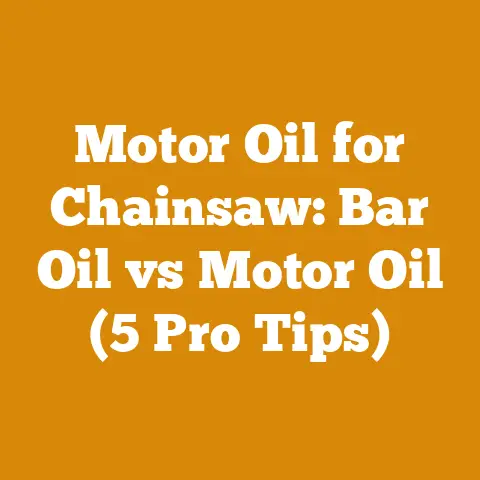WoodMizer LT35 Troubleshooting (5 Key Wood Processing Fixes)
Imagine your WoodMizer LT35 is a trusty steed, ready to transform raw logs into valuable lumber.
But even the best workhorses stumble sometimes.
When your LT35 starts acting up, it can feel like your whole wood processing operation grinds to a halt.
Over the years, I’ve spent countless hours troubleshooting these machines, and I’ve learned that a systematic approach and a bit of know-how can get you back on track quickly.
This article is your guide to diagnosing and fixing five key issues that commonly plague the WoodMizer LT35, ensuring your sawmill stays productive and your lumber keeps flowing.
I’ll also dive into the costs associated with keeping your LT35 running smoothly, because let’s face it, time is money, and downtime can quickly eat into your profits.
WoodMizer LT35 Troubleshooting: 5 Key Wood Processing Fixes
1. Blade Issues: The Heart of the Cut
A dull, improperly tensioned, or damaged blade is the most common culprit behind poor cut quality and reduced production.
Blades are essentially the heart and soul of any sawmill operation, and I’ve learned this the hard way more than once.
I recall a time I was milling some particularly knotty oak, and I thought I could push through with a blade that was already showing signs of wear.
Big mistake!
I ended up with a wavy cut, wasted wood, and a significant delay.
Now, I’m religious about blade maintenance.
Problem:
- Wavy Cuts: Uneven board thickness, indicating blade instability or dullness.
- Blade Breakage: Snapping or cracking of the blade during operation.
- Dull Cuts: Slow cutting speed and excessive sawdust production.
- Blade Wander: Blade drifting off the intended cut line.
Solution:
- Sharpening: Regular sharpening is crucial.
I recommend sharpening after every 2-4 hours of cutting, depending on the wood species and condition.
A good blade sharpener is an investment that pays for itself quickly. - Tensioning: Ensure the blade is properly tensioned according to the manufacturer’s specifications.
Use a blade tension gauge to verify.
Too little tension causes wavy cuts; too much can lead to breakage. - Blade Alignment: Check the blade guides and rollers for proper alignment.
Misalignment can cause blade wander and premature wear. - Blade Selection: Use the correct blade type for the wood species.
Hardwoods require different blades than softwoods.
Consider blade thickness, tooth pitch, and kerf. - Blade Inspection: Regularly inspect the blade for cracks, chips, or other damage.
Replace damaged blades immediately.
Cost Considerations:
- Blade Cost: Blades range from \$30 to \$100 each, depending on the type and length.
I find that buying in bulk can often save you money. - Sharpening Cost: Professional sharpening services typically charge \$10-\$20 per blade.
A blade sharpener can be purchased for around \$500-\$2000, depending on the features. - Downtime Cost: Each hour of downtime can cost you production time and potentially lost revenue.
Preventing blade issues is a worthwhile investment.
Data Point: According to a WoodMizer survey, blade-related issues account for approximately 40% of sawmill downtime.
Practical Tip: Keep a log of blade usage and sharpening frequency to optimize your blade maintenance schedule.
2. Hydraulic System Issues: Powering the Mill
The hydraulic system is the muscle behind the LT35, powering the head up/down, log loaders, and other functions.
When it malfunctions, your mill becomes a very expensive paperweight.
I remember a time when my hydraulic system started leaking.
I ignored it for a while, thinking it was just a minor issue.
Eventually, the leak got so bad that the mill wouldn’t lift the head, and I was stuck with a half-cut log.
That taught me a valuable lesson about preventative maintenance.
Problem:
- Slow or Erratic Movement: Sluggish or jerky operation of hydraulic components.
- Hydraulic Leaks: Oil leaks from hoses, fittings, or cylinders.
- Loss of Power: Inability to lift or move heavy logs.
- Overheating: Excessive heat buildup in the hydraulic system.
Solution:
- Fluid Level: Check the hydraulic fluid level regularly and top off as needed.
Use the correct type of fluid specified by the manufacturer. - Filter Replacement: Replace the hydraulic filter according to the maintenance schedule.
A clogged filter restricts flow and can damage the pump. - Hose Inspection: Inspect hoses for cracks, leaks, or wear. Replace damaged hoses immediately.
- Fitting Tightening: Check and tighten loose fittings to prevent leaks.
- Pump Inspection: Listen for unusual noises from the hydraulic pump.
A noisy pump may indicate wear or damage. - Cylinder Inspection: Check cylinders for leaks or damage to the seals.
Cost Considerations:
- Hydraulic Fluid: Hydraulic fluid costs around \$5-\$10 per gallon.
- Hydraulic Filter: Filters range from \$10-\$30 each.
- Hoses and Fittings: Replacement hoses and fittings can cost anywhere from \$20 to \$100+, depending on the size and type.
- Pump Repair/Replacement: Hydraulic pump repairs can cost several hundred dollars, while a new pump can cost \$500-\$1500.
- Labor Costs: If you’re not comfortable working on the hydraulic system yourself, expect to pay a mechanic \$75-\$150 per hour.
Data Point: According to industry reports, hydraulic system failures account for approximately 20% of sawmill downtime.
Practical Tip: Keep a supply of spare hydraulic fluid, filters, and common fittings on hand to minimize downtime.
3. Electrical System Issues: Keeping the Power On
The electrical system is the nervous system of your LT35, controlling everything from the engine to the blade lubrication.
Electrical problems can be frustrating to diagnose, but a systematic approach can help you pinpoint the issue.
I once spent an entire afternoon chasing a ghost in my electrical system.
The mill would randomly shut down, and I couldn’t figure out why.
After checking every wire and connection, I finally found a loose ground wire.
It was a simple fix, but it cost me a lot of time and aggravation.
Problem:
- Engine Starting Problems: Difficulty starting the engine or no start at all.
- Electrical Shorts: Fuses blowing or circuit breakers tripping.
- Wiring Problems: Damaged or corroded wires.
- Sensor Malfunctions: Faulty sensors affecting engine performance or other functions.
- Control Panel Issues: Malfunctioning switches or displays.
Solution:
- Battery Check: Ensure the battery is fully charged and in good condition.
Clean the battery terminals. - Fuse/Breaker Check: Check for blown fuses or tripped circuit breakers.
Replace blown fuses with the correct amperage. - Wiring Inspection: Inspect all wiring for damage, corrosion, or loose connections.
Repair or replace damaged wires. - Grounding: Ensure all grounding connections are clean and secure.
- Sensor Testing: Use a multimeter to test sensors for proper function.
- Control Panel Inspection: Check switches and displays for proper operation.
Cost Considerations:
- Battery: A new battery can cost \$100-\$300.
- Fuses/Breakers: Fuses and breakers are relatively inexpensive, typically costing a few dollars each.
- Wiring: Replacement wiring can cost \$1-\$5 per foot.
- Sensors: Replacement sensors can range from \$20-\$100+, depending on the type.
- Control Panel Repair/Replacement: Control panel repairs can cost several hundred dollars, while a new panel can cost \$500-\$2000.
- Labor Costs: Electrical repairs can be complex, so consider hiring a qualified electrician if you’re not comfortable working on electrical systems.
Data Point: Electrical system issues account for approximately 15% of sawmill downtime.
Practical Tip: Keep a wiring diagram of your LT35 handy for troubleshooting electrical problems.
4. Engine Issues: The Powerhouse
The engine is the heart of your LT35, providing the power to drive the blade and other components.
Engine problems can bring your entire operation to a standstill.
I’ve had my share of engine troubles over the years, from simple things like clogged air filters to more serious issues like fuel injection problems.
The key is to stay on top of preventative maintenance and address problems early before they escalate.
Problem:
- Engine Won’t Start: Failure of the engine to start.
- Rough Running: Engine runs unevenly or sputters.
- Loss of Power: Engine lacks power or stalls under load.
- Overheating: Engine temperature exceeds normal operating range.
- Excessive Smoke: Blue, black, or white smoke coming from the exhaust.
Solution:
- Fuel System Check: Ensure the fuel tank is full and the fuel is fresh.
Check the fuel filter for clogs. - Air Filter Check: Clean or replace the air filter regularly.
A clogged air filter restricts airflow and can reduce engine performance. - Spark Plug Check: Check the spark plug for fouling or damage.
Replace the spark plug as needed. - Ignition System Check: Check the ignition system for proper function.
- Cooling System Check: Check the coolant level and inspect the radiator for leaks or clogs.
- Oil Level Check: Ensure the engine oil level is within the proper range.
Cost Considerations:
- Fuel: Fuel costs vary depending on the type of fuel and local prices.
- Air Filter: Air filters typically cost \$10-\$30.
- Spark Plug: Spark plugs cost a few dollars each.
- Fuel Filter: Fuel filters cost \$5-\$15.
- Oil: Engine oil costs around \$5-\$10 per quart.
- Engine Repair/Replacement: Engine repairs can range from a few hundred dollars to several thousand, depending on the severity of the problem.
A new engine can cost \$3000-\$8000+. - Labor Costs: Engine repairs can be complex, so consider hiring a qualified mechanic if you’re not comfortable working on engines.
Data Point: Engine problems account for approximately 10% of sawmill downtime.
Practical Tip: Keep a log of engine maintenance and repairs to track potential issues and plan for future maintenance.
5. Carriage Issues: Smooth Movement is Key
The carriage is the framework that supports the saw head and moves it along the log.
Smooth, consistent carriage movement is essential for accurate cuts.
Carriage problems can lead to wavy cuts, uneven board thickness, and reduced production.
I remember a time when my carriage started sticking.
I tried lubricating the rails, but it didn’t help.
Eventually, I discovered that the wheels were worn and needed to be replaced.
It was a relatively simple fix, but it made a huge difference in the quality of my cuts.
Problem:
- Carriage Sticking: Carriage movement is jerky or uneven.
- Wobbly Carriage: Carriage vibrates or shakes during operation.
- Uneven Cuts: Board thickness varies due to carriage instability.
- Wheel Wear: Wheels are worn or damaged.
- Rail Damage: Rails are bent or damaged.
Solution:
- Rail Cleaning: Clean the carriage rails regularly to remove sawdust and debris.
- Lubrication: Lubricate the carriage rails and wheels with the appropriate lubricant.
- Wheel Inspection: Inspect the carriage wheels for wear or damage.
Replace worn or damaged wheels. - Rail Alignment: Check the alignment of the carriage rails.
Misaligned rails can cause carriage sticking and uneven cuts. - Bearing Inspection: Check the carriage bearings for wear or damage.
Replace worn or damaged bearings.
Cost Considerations:
- Lubricant: Lubricant costs a few dollars per can or bottle.
- Wheels: Replacement carriage wheels can cost \$50-\$200 each.
- Bearings: Replacement bearings can cost \$10-\$50 each.
- Rail Repair/Replacement: Rail repairs can cost several hundred dollars, while new rails can cost \$500-\$2000+.
- Labor Costs: Carriage repairs can be complex, so consider hiring a qualified mechanic if you’re not comfortable working on the carriage.
Data Point: Carriage problems account for approximately 15% of sawmill downtime.
Practical Tip: Regularly inspect the carriage for wear and damage to catch problems early.
The True Cost of Wood Processing: A Deeper Dive
Beyond the immediate costs of fixing these common issues, it’s crucial to understand the broader economic landscape of wood processing.
This involves breaking down material costs, labor, and the often-overlooked expenses of tool maintenance and permits.
Material Costs: More Than Just the Wood
The type of wood you’re processing significantly impacts your overall costs.
Different species have different prices, and the quality of the wood (presence of knots, straightness of the grain) affects yield and processing time.
Wood Species and Pricing:
- Softwoods (Pine, Fir, Spruce): Generally less expensive, ranging from \$0.50 to \$1.50 per board foot depending on grade and availability.
I’ve found that sourcing directly from local landowners can sometimes yield better prices. - Hardwoods (Oak, Maple, Cherry): More expensive, ranging from \$2 to \$5+ per board foot.
The price can skyrocket for figured woods or rare species.
I once paid a premium for a batch of curly maple, but the resulting furniture was worth every penny. - Exotic Woods (Mahogany, Teak, Ebony): The most expensive, often exceeding \$10 per board foot.
Sourcing these woods ethically and legally is paramount.
Wood Quality and Yield:
- Knotty Wood: More difficult to process, leading to lower yields and increased blade wear.
I factor in an extra 10-20% of material when working with knotty wood. - Straight-Grained Wood: Easier to process, resulting in higher yields and less waste.
- Rot and Decay: Avoid processing wood with rot or decay, as it can damage your equipment and produce unusable lumber.
Data Point: According to the USDA Forest Service, the average price of standing timber varies significantly by region and species, ranging from \$20 per thousand board feet for low-grade pine to \$200+ per thousand board feet for high-grade hardwood.
Practical Tip: Develop relationships with local sawmills and landowners to secure reliable sources of quality wood at competitive prices.
Labor Costs: The Human Element
Whether you’re a one-person operation or have a crew, labor costs are a significant factor in wood processing.
These costs include wages, benefits, and worker’s compensation insurance.
Logging Crew vs. Firewood Handlers:
- Logging Crew: Typically paid hourly or by the volume of timber harvested.
Average hourly rates range from \$20-\$40 per hour, depending on experience and location. - Firewood Handlers: Often paid by the cord of wood processed.
Piece rates range from \$20-\$50 per cord, depending on the difficulty of the work.
Wage Variations:
- Experience: Experienced workers command higher wages.
Investing in training and development can improve productivity and reduce errors. - Location: Wages vary by region, with higher costs in urban areas.
- Benefits: Providing benefits like health insurance and paid time off can attract and retain skilled workers.
Data Point: The Bureau of Labor Statistics reports that the median hourly wage for logging workers in the United States is around \$21 per hour.
Practical Tip: Implement efficient work processes and provide proper training to maximize labor productivity.
Tool Costs: Chainsaws, Splitters, and Maintenance
The tools you use for wood processing represent a significant investment.
Chainsaws, splitters, and other equipment require regular maintenance and eventual replacement.
Chainsaws:
- Purchase Cost: Chainsaws range from \$200 for a basic homeowner model to \$1000+ for a professional-grade saw.
- Maintenance: Regular maintenance includes sharpening the chain, cleaning the air filter, and replacing spark plugs.
I budget about \$50-\$100 per year for chainsaw maintenance. - Fuel and Oil: Fuel and oil costs can add up quickly, especially for heavy use.
Splitters:
- Purchase Cost: Log splitters range from \$500 for a small electric model to \$5000+ for a large hydraulic splitter.
- Maintenance: Log splitters require regular maintenance, including changing the hydraulic fluid and lubricating moving parts.
- Fuel (for gas-powered models): Fuel costs can be significant for gas-powered splitters.
Tool Maintenance:
- Preventative Maintenance: Regular cleaning, lubrication, and inspection can extend the life of your tools and prevent costly repairs.
- Repair Costs: Be prepared for occasional repairs.
I set aside a contingency fund each year to cover unexpected repair costs. - Replacement Costs: Eventually, tools will need to be replaced.
Factor in depreciation and plan for replacement costs.
Data Point: A study by the University of Minnesota found that the average annual cost of maintaining a chainsaw is around \$75.
Practical Tip: Invest in high-quality tools and equipment and follow a regular maintenance schedule to maximize their lifespan.
Permits and Regulations: The Hidden Costs
Depending on your location and the scale of your operation, you may need to obtain permits for logging, firewood sales, or other wood processing activities.
These permits can add to your overall costs.
Logging Permits:
- Cost: Logging permits can range from a few dollars to several hundred dollars, depending on the location and the size of the harvest.
- Requirements: Permit requirements may include environmental impact assessments, erosion control plans, and reforestation plans.
Firewood Sales Permits:
- Cost: Firewood sales permits are typically less expensive than logging permits, but they are still necessary in many areas.
- Requirements: Permit requirements may include proof of insurance, firewood source documentation, and compliance with quarantine regulations.
Compliance Costs:
- Environmental Regulations: Compliance with environmental regulations can add to your costs.
This may include implementing erosion control measures, protecting water quality, and preserving wildlife habitat. - Safety Regulations: Compliance with safety regulations is essential to protect workers and prevent accidents.
This may include providing personal protective equipment, training workers in safe work practices, and maintaining a safe work environment.
Data Point: The cost of complying with environmental regulations can add 10-20% to the cost of logging operations.
Practical Tip: Research and comply with all applicable permits and regulations to avoid fines and legal issues.
Optimizing Costs and Managing Your Budget: Strategies for Success
Now that we’ve explored the various cost factors involved in wood processing, let’s discuss some strategies for optimizing costs and managing your budget effectively.
Accurate Cost Estimation: Know Your Numbers
The first step in effective cost management is to accurately estimate your costs.
This involves breaking down all cost components and developing a detailed budget.
Estimating Timber Costs:
- Volume Estimation: Accurately estimate the volume of timber you plan to harvest or purchase.
Use tools like diameter tape and height poles to measure trees and calculate board feet or cords. - Pricing Research: Research current timber prices in your area.
Contact local sawmills, landowners, and forestry consultants to get price quotes. - Transportation Costs: Factor in the cost of transporting timber to your processing site.
Estimating Labor Costs:
- Hourly Rates: Determine the hourly rates for all workers involved in the project.
- Time Estimates: Estimate the amount of time required for each task, such as felling trees, skidding logs, and processing lumber.
- Overhead Costs: Factor in overhead costs such as worker’s compensation insurance and payroll taxes.
Estimating Tool and Equipment Costs:
- Maintenance Costs: Estimate the cost of maintaining your tools and equipment.
- Repair Costs: Set aside a contingency fund to cover unexpected repair costs.
- Replacement Costs: Plan for the eventual replacement of your tools and equipment.
Data Point: Studies show that accurate cost estimation can reduce project costs by up to 15%.
Practical Tip: Use a spreadsheet or project management software to track your costs and compare them to your budget.
Negotiating Prices: Get the Best Deals
Negotiating prices with suppliers and contractors can help you reduce your overall costs.
Timber Purchases:
- Shop Around: Get price quotes from multiple suppliers.
- Negotiate Volume Discounts: Ask for discounts on large orders.
- Consider Alternative Species: Explore alternative wood species that may be less expensive.
Labor Contracts:
- Get Multiple Bids: Get bids from multiple contractors.
- Negotiate Rates: Negotiate hourly rates or piece rates.
- Consider Performance-Based Contracts: Consider performance-based contracts that reward contractors for meeting specific goals.
Equipment Purchases:
- Shop Around: Get price quotes from multiple dealers.
- Negotiate Discounts: Ask for discounts on new or used equipment.
- Consider Leasing: Consider leasing equipment instead of buying it outright.
Data Point: Effective negotiation can reduce project costs by up to 10%.
Practical Tip: Be prepared to walk away from a deal if you can’t get the price you need.
Minimizing Waste: Maximize Your Yield
Minimizing waste is crucial for maximizing your profits.
This involves optimizing your cutting techniques, utilizing scrap wood, and properly storing lumber.
Cutting Techniques:
- Optimize Cut Patterns: Plan your cuts carefully to minimize waste.
- Use Sharp Blades: Sharp blades produce cleaner cuts and less sawdust.
- Avoid Overcutting: Avoid cutting boards too wide or too long.
Scrap Wood Utilization:
- Firewood: Use scrap wood for firewood.
- Craft Projects: Use scrap wood for small craft projects.
- Mulch: Use scrap wood as mulch in your garden.
Lumber Storage:
- Stack Properly: Stack lumber properly to prevent warping and twisting.
- Protect from Moisture: Protect lumber from moisture to prevent rot and decay.
- Control Temperature and Humidity: Control temperature and humidity to minimize shrinkage and expansion.
Data Point: Reducing waste can increase your lumber yield by up to 20%.
Practical Tip: Implement a waste management plan to minimize waste and maximize your profits.
Drying Time Calculation: A Key Factor in Wood Processing
Air drying and kiln drying are two common methods for reducing the moisture content of wood.
The drying time depends on several factors, including the wood species, thickness, initial moisture content, and environmental conditions.
Air Drying:
- Factors Affecting Drying Time: Wood species, thickness, initial moisture content, temperature, humidity, and air circulation.
- Estimating Drying Time: A general rule of thumb is that air drying takes about one year per inch of thickness.
However, this can vary depending on the factors mentioned above. - Formula for Estimating Air Drying Time: Drying Time (months) = K * Thickness (inches), where K is a constant that varies depending on the wood species and environmental conditions.
Kiln Drying:
- Factors Affecting Drying Time: Wood species, thickness, initial moisture content, kiln temperature, and humidity.
- Estimating Drying Time: Kiln drying is much faster than air drying, typically taking a few days to a few weeks.
- Formula for Estimating Kiln Drying Time: Drying Time (days) = C * Thickness (inches) / Kiln Temperature (°F), where C is a constant that varies depending on the wood species and kiln design.
Data Point: Kiln drying can reduce the moisture content of wood to as low as 6-8%, while air drying typically only reduces it to around 12-15%.
Practical Tip: Use a moisture meter to monitor the moisture content of your wood during the drying process.
Actionable Takeaways and Next Steps
By understanding the common problems that can plague your WoodMizer LT35 and the costs associated with wood processing, you can take proactive steps to improve your efficiency, reduce your expenses, and maximize your profits.
Here are some actionable takeaways and next steps:
- Implement a Preventative Maintenance Program: Regularly inspect and maintain your equipment to prevent breakdowns and extend its lifespan.
- Develop a Detailed Budget: Track your costs and compare them to your budget to identify areas where you can save money.
- Negotiate Prices: Shop around and negotiate prices with suppliers and contractors to get the best deals.
- Minimize Waste: Optimize your cutting techniques and utilize scrap wood to maximize your yield.
- Invest in Training: Train your workers in safe and efficient work practices.
- Comply with Regulations: Research and comply with all applicable permits and regulations.
- Stay Informed: Keep up-to-date on industry trends and best practices.
By following these steps, you can ensure that your wood processing operation is efficient, profitable, and sustainable.
Remember, the journey of a thousand board feet begins with a single log, and careful planning and execution can make all the difference.






